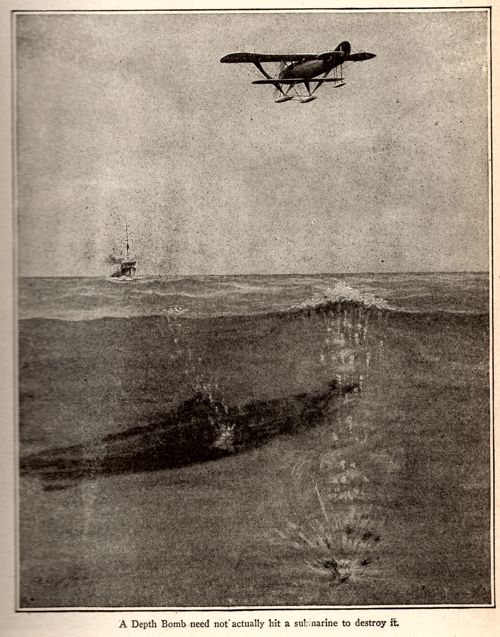Submarine Warfare in
World War
One
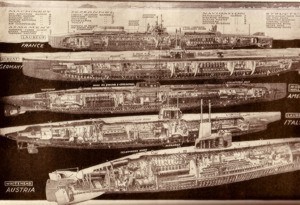
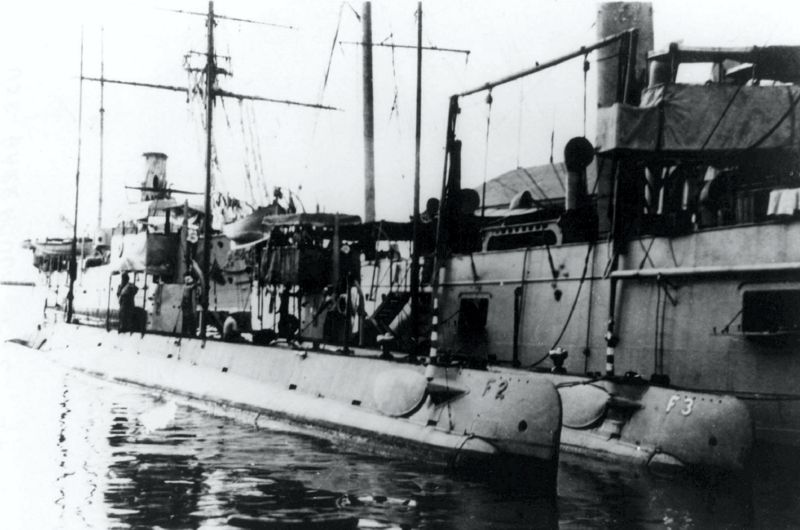
F-2 (SS-21) & F-3 (SS-22) alongside tender, date and location unknown.
US Navy photo
F class subs built in the 1910's
142 ft long, they carried a crew of 1 officer and 21 enlisted men, primarily used for submerged practice and torpedo exercises. in the Pacific.
US Navy photo
Diagram of WWI Submarines
- France
- German
- United States
- Italy
- Austria
Freedom’s Triumph
Courtesy of Indiana War Memorial Archives
USS C1 (SS-9)
Formerly the USS Octopus
Built at Fore River Shipyard, Quincy, Mass. Launched 4 October 1916
- Length overall 105'
- Normal displacement: 238 Tons
- Submerged displacement: 275 Tons
- Tested depth 200'
- 2 18" Torpedo tubes in the bow, 2 reloads for a total of four torpedoes
- Designed speed: surface 14, submerged 10
- 11 Knots on surface, 9 Knots submerged
- Range 776 Nautical Miles
- Reassigned Submarine Group 1, Torpedo Flotilla, Atlantic Fleet
- Served in the Panamanian waters operating out of Guantanamo Bay, Cuba.
The US Navy had 72 submarines in World War 1 but played a minor part in the war. The German U-Boats were active in the Baltic, Mediterranean and Black Seas and were effective in interfering with Allied supply convoys.
The sinking of the Lusitania turned the American People against Germany. The US demanded Germany to stop and they did so with the realization that their unrestricted submarine warfare could bring the US into the war. The Germans assumed the US could not mobilize quickly enough to stop a German victory even if they joined the Allies.
The German submarine SM U-p sank three British cruisers in under an hour established the potency of submarine warfare.
USS Grampus (SS-4)
Plunger-class
She was constructed at Mare Island, San Francisco, California in 1900. Lieutenant Arthur MacArthur was in command, the brother of Douglas MacArthur. She was used for training and participated in relief efforts after the earthquake devastation of San Francisco in 1906. In 1915 she was taken to the Philippines along with her sister ship, SS-6. the Pike, to serve out of the Subic Bay Naval Base. During WW1 A-3 was given the hull number SS-4 and patrolled the waters off of the entrance to Manila Bay.

4243 US Submarine "Grampus"
Postcard photo US Naval Archives 0800421
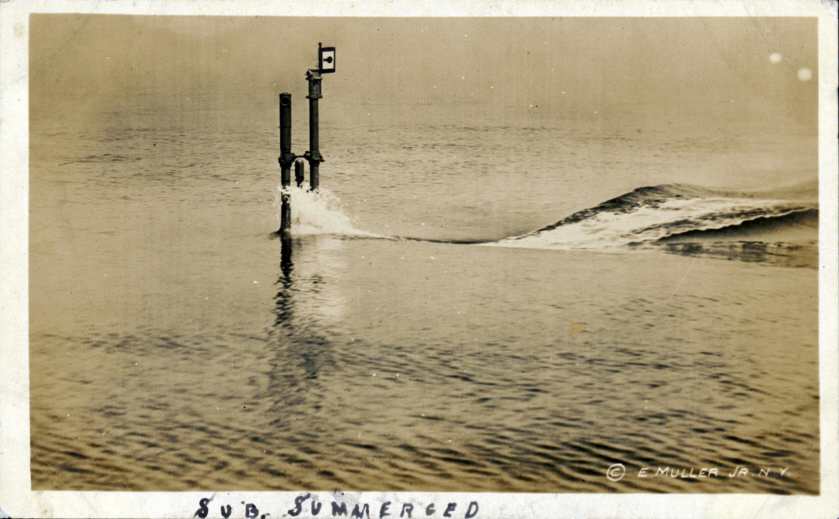
Real-photo postcard of a photograph of a U.S. Navy submarine submerging below the water somewhere along the Atlantic Coast during World War I.
US Army Signal Corps Photo
![Subs Real-photo postcard of an unidentified troop transport ship [believed to be the USS Powhatan, a U.S. Navy troop transport ship] parked in an unidentified harbor [believed to be in France], with three U.S. Navy submarines alongside the ship tied to the ship with ropes. Two of the three submarines have American flags flying from their bows. Image taken during World War I (Undated).](https://wwvets.org/wp-content/uploads/2020/08/Subs.jpg)
Real-photo postcard of an unidentified troop transport ship [believed to be the USS Powhatan, a U.S. Navy troop transport ship] parked in an unidentified harbor [believed to be in France], with three U.S. Navy submarines alongside the ship tied to the ship with ropes. Two of the three submarines have American flags flying from their bows. Image taken during World War I (Undated).
US Army Signal Corps
Robert Franklin Menefee, U.S. Navy,
Decatur County, Indiana
“I did five-month service in Canada in Naval aviation and was shipped Charleston South Carolina, where I was placed in Division 8 Submarine Force, US Atlantic Fleet on the US Submarine 0-3. We sailed from Charleston South Carolina to the Azores and from there to Savanna Georgia and from there to Cuba, where we stayed one month. We went from there north and I got released in New London, Connecticut, serving one year in the Navy.
Earl Dow Greer, Master Mechanic 2C, U.S. Navy,
Vanderburg County, Indiana
Enlisted May 15, 1918, at Indianapolis, Indiana and on the following 21st, reported for duty at Great Lakes. Entered as a Landsmen for radio, but owing to the wait, asked to be sent overseas. Reached New York City on July 4 and the following September 1, arrived at New London, Connecticut submarine base along the East Coast. “On September 26, I was ordered to go aboard the USSC 191, then sailing for Brest, France. We arrived at Bermuda in the latter part of September and then sailed to Porto del Gotto, Azores. After repairs, we sailed for Portugal and Lisbon. We were ordered to go South and pick up 20 submarines of the German government, operating between Gibraltar in Genoa, Italy. We arrived there just in time to finish the Gibraltar barrage. Our division sunk three submarines. Soon the armistice was signed and we sailed home but didn't reach home until the latter part of May.
Marion Francis Howe, Seaman, 2nd Class Navy,
Tippecanoe County, Indiana
Entered service April 9, 1917. Stationed at Great Lakes Naval Training School, Ill. Assigned to the U. S. S. “ Michigan.” Transferred to an Oil Tanker and made one trip to England. Transferred to the U. S. S. “President Lincoln,” and on his fourth trip the boat was sunk by a German submarine, May 30, 1918, two days out from France, was picked up by a destroyer and brought to New York. After a 15-day furlough, he was assigned to military police duty in New York in rounding up slackers. Was later assigned to the transport “Corrello,” where he made trips between France and the United States. Born at West Point, Ind., June 9, 1893, son of William and Phoebe Howe. Home is Lafayette. Ind.
Frank Charles Hillman, AEF,
Ripley County, Indiana
“Transport was attacked by submarines, second and third days out from Liverpool. Both were sunk. One transport sank because of damage after making port in Liverpool.
“One trip to the front with ammunition started out with twenty-one trucks. Returned with three. Five were damaged beyond repair. This was at St. Mihiel in the drive toward Metz.”
James Earl Buchanan, Private,
Decatur County, Indiana
“On the night of October 13, 1918, at 11: PM, as we were entering the Irish Sea from the Atlantic, our ship was chased and torpedoed by a German submarine. We got to land, however, but our battleship was damaged. considerably.”
Forrest S. Rypolt, U.S. Army, Engineers,
Decatur County, Indiana
“Was in submarine battle in Biscayne Bay in August 11, 1918. One day before landing in Brest, France, official credit was given on destroying 4 German submarines on that day. The NS Ship Main, on which they were three Companies of the 44th Engineers, had several very narrow escapes, one torpedo from a submarine missing the Main about 40 feet. This is said to be one, if not the most perfect submarine attack in war.”
Harold Hooker, Sergeant, Field Artillery,
Tippecanoe County, Indiana
Entered service in April 1917, enlisted in Coast Artillery and sent to Jefferson Barracks, Mo. Transferred to Camp Totten, N. Y., where on June 16, 1917, he was made Lance Corporal. Transferred to the National Army and was sent to Camp Meade, Md., where he was given the rank of sergeant in Truck Co. No.3, 304th Ammunition Train. Was made a Sergeant of Ordnance on April 18, 1918, and was sent overseas in July 1918. Near the entrance of the Irish Sea, the troopships were attacked by two submarines but without damage to the fleet. One “sub” was destroyed by a depth bomb and the other escaped. When the armistice was signed he was attending a school in France. Born at Rochester, Ind., June 9, 1898, son of Brainard and Eva A. Hooker. Graduate of West Lafayette high school. Home is Dayton, Ind.
A Depth Bomb need not actually hit a submarine to destroy it.
The People's War Book & Atlas of the World, 1921
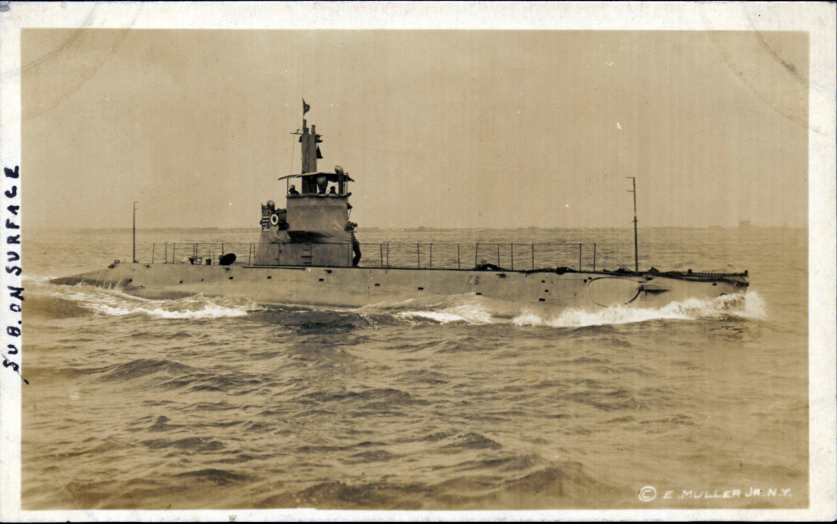
Real-photo postcard of a photograph of a U.S. Navy submarine sailing on the surface of the water somewhere along the Atlantic Coast during World War I
US Army Signal Corps Photo
